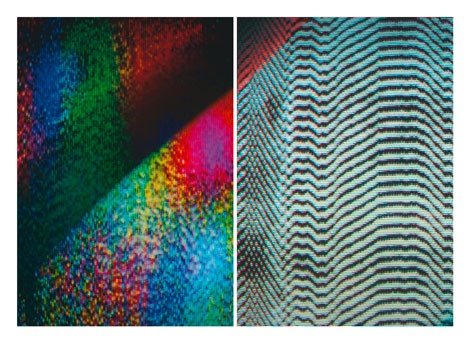Tauba Auerbach
„Static 18”, „Static 19” (2011)
The American artist Tauba Auerbach first drew attention with calligraphic images whose arrangement and sequence recall drawings of letters oscillating between meaning and its loss, raising the fundamental linguistic question of the relationship between signifier and signified. Now the variations of letters generate new structures of meaning, now they utterly fall apart, leaving nothing but decorative geometric ornamentation. Is the drawn figure a written letter, or is that an association dependent on the degree of recognition? Does spoken language manifest itself in the sign, or does written language lose its true meaning in this transfer? Also inherent to Auerbach’s work is the antagonism, now virtually a thing of the past, between the digital and analogue registers. In 2008, as US broadcasters were replacing analogue with digital television signals, the artist, employing a complex procedure, sought to capture the visual “white noise”. Yet do these stills, generated from an analogue 35 mm film, then scanned and reprinted on analogue photographic paper using computer-generated light, suggest the random visual production of an old tube television, or rather the matrix of a parallel world? For Texte zur Kunst, Tauba Auerbach has selected two of these pictures. The photographs “Static 18” and “Static 19” might contain the potential for any conceivable image. If the light spectra arranged themselves in a slightly different order, these would perhaps be stills from “Saturday Night Live”.
The two different C-prints Tauba Auerbach has selected for Texte zur Kunst bear the titles “Static 18” and “Static 19”. Each photograph measures 58.1 × 40.6 cm (18 × 25.8 in) and is signed and numbered on the back. The work comes in an edition of 60 + 20 APs, or 30 + 10 APs per motif.

